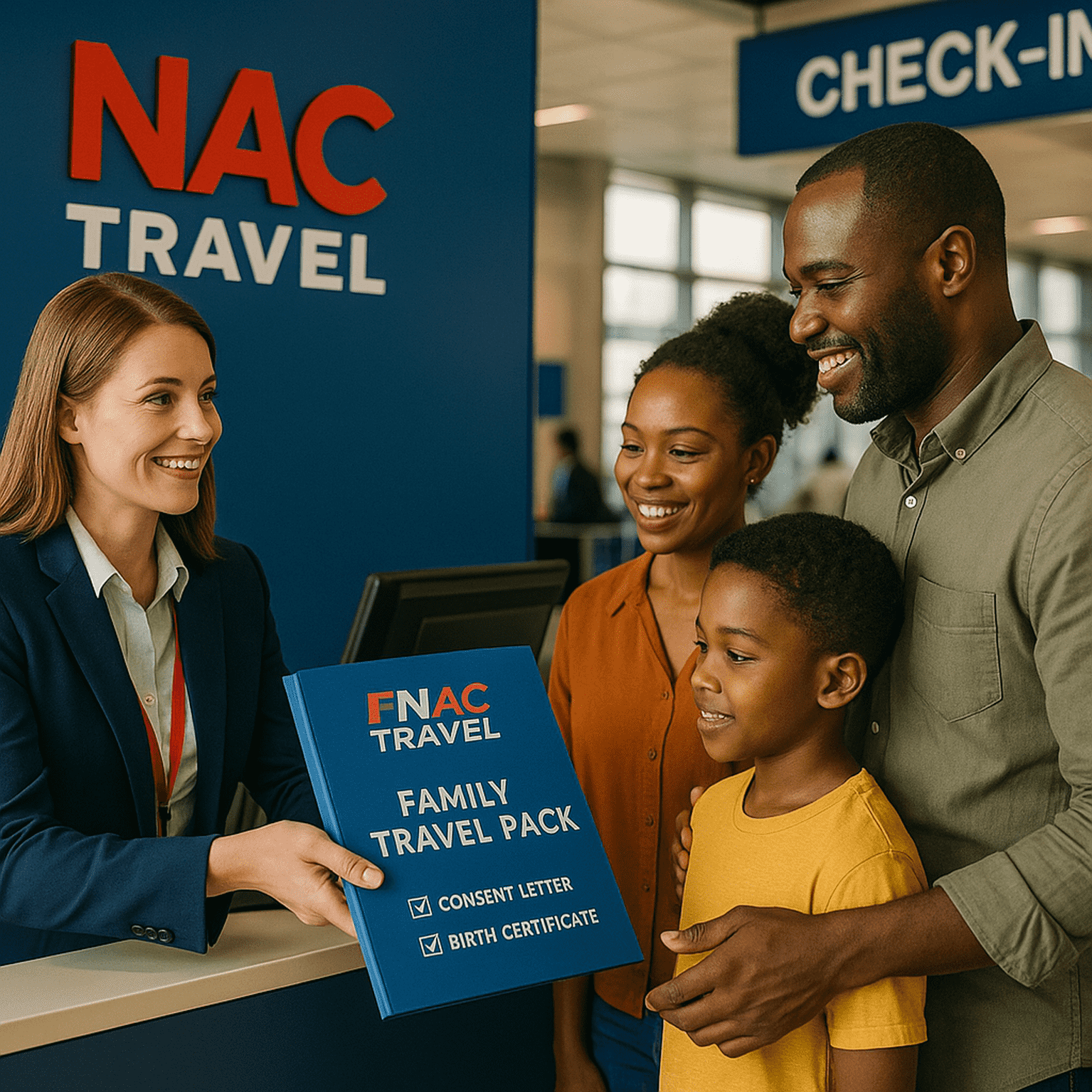Nothing stalls a happy trip faster than a check-in agent asking for paperwork you did not bring. When a child crosses a border, airlines and immigration officers often ask for proof that the adults have the right to travel with them. The rules vary by country, but the fundamentals are the same: show identity, show the relationship, and show permission from any parent or legal guardian who is not present. Here is a simple guide, plus how NAC Travel International packages everything so your family can sail through the airport.
What airlines and border officers want to see
-
Child’s identity
-
Valid passport or national travel document
-
Visa or eTA if required for the destination or transit
-
-
Proof of relationship
-
Original or certified copy of the full birth certificate that lists parents
-
Adoption certificate or guardianship order if applicable
-
Documents must match the names in the passports or have evidence of name change
-
-
Permission from non-traveling parent or guardian
-
A signed consent letter for international travel
-
Contact details for the non-traveling parent or guardian
-
Copy of the non-traveling parent’s photo ID that matches the signature
-
-
Legal status if parents are separated or there is a special arrangement
-
Court order that grants custody or travel authority
-
Death certificate of a parent if applicable
-
Police affidavit or notarized statement in exceptional circumstances
-
-
Supporting items that smooth the process
-
Itinerary with booking references and addresses of where the child will stay
-
Proof of accommodation or invitation from hosts
-
Medical consent for emergency treatment when traveling without a parent
-
Common scenarios and the safest documents to carry
-
Two parents traveling together: passports, birth certificate, and itinerary.
-
One parent traveling with the child: consent letter from the other parent, copy of that parent’s ID, birth certificate.
-
Child traveling with grandparents or relatives: consent letters from both parents, copies of their IDs, birth certificate, contact numbers.
-
School group or sports team: group consent forms, list of chaperones and minors, medical consent letters, and contact sheet for all guardians.
-
Different surnames between parent and child: full birth certificate plus any name-change or marriage certificate that links the names.
-
Separated or divorced parents: the court order that sets travel rights, plus a consent letter when required by the order.
-
Adoption or legal guardianship: adoption decree or guardianship order; consider certified copies and translations.
Consent letter essentials
A clear one-page letter usually includes:
-
Child’s full name, date of birth, passport number
-
Traveling parent or guardian’s full details and passport number
-
Non-traveling parent or guardian’s full details and passport number
-
Trip dates, destinations, flight numbers, where the child will stay
-
A statement granting permission for travel during the stated dates
-
Emergency contact details for both parents or guardians
-
Signature of the non-traveling parent or guardian; date and place of signing
Notarization or attestation: many countries prefer or require a notarized signature. Some destinations request an apostille or consular legalization if the letter is signed in a different country. When in doubt, notarize and carry certified copies.
Language: carry an English version and a translation into the destination language if needed. Use an accredited translator or a template accepted by the consulate.
Departure-day pack for families
-
Child’s passport and visas
-
Parent or guardian passports
-
Full birth certificate or legal proof of relationship
-
Signed consent letter with ID copy of the non-traveling parent or guardian
-
Custody or guardianship orders, adoption papers, death certificate if applicable
-
Medical consent letter and health insurance details
-
Printed itinerary, accommodation confirmations, and contact sheet
-
Two sets of certified copies; digital scans stored securely on your phone
Tips that prevent last-minute stress
-
Match names across all documents. If names differ, bring the name-linking certificate.
-
Use certified copies where possible. Some officers accept certified copies in place of originals; others will ask to see the original.
-
Check airline policy and the destination’s government site before paying for flights. Rules can change, and carriers follow destination requirements at boarding.
-
Arrive early when traveling with minors. Document checks take longer for families.
-
Carry a simple explanation letter for unusual situations. One paragraph can prevent confusion.
How NAC Travel International helps
Country-specific consent templates
We provide the exact letter format that airlines and border posts expect for your route. Fields are prefilled with your itinerary so nothing is missed.
Notarization and legalization guidance
We confirm whether your letter should be notarized, apostilled, or legalized by a consulate; then we map the steps and timing so documents are ready before check-in.
Departure-day pack that airlines accept
You receive a labeled folder and a digital backup: passports list, birth certificate copy, consent letters, court orders, medical consent forms, and itinerary. Everything is in the order staff typically review.
Name-matching and translation support
We link different surnames with the right certificates and arrange certified translations when required.
On-trip help
If plans change mid-journey, we update consent dates and resend digital copies to you and the airline desk.
Bottom line
When you travel with a minor, preparation beats persuasion. Bring proof of identity, proof of your relationship, and a clear consent letter from any parent or guardian who is not present. Package the documents in a way that is simple for staff to read. NAC Travel International builds that pack for you and guides the notary steps, so your focus stays on the trip rather than the paperwork.
